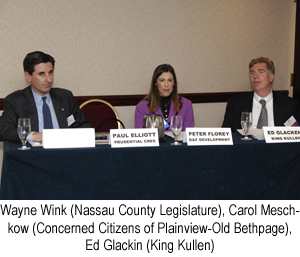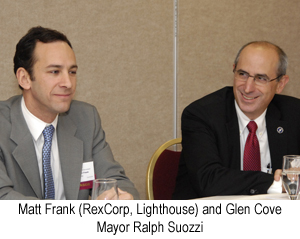THank You To EVeryone Who Participated in the 7th Annual Smart Growth Summit
Attendees of the Summit also addressed State and Federal budget priorities to support Smart Growth plans. There was consensus that Smart Growth projects are the very initiatives that will help Long Island and the region out of a recession. A survey was conducted at the Summit, identifying areas where there was consensus to cut the State budget and areas were additional investment is needed. The Summit also addressed where federal stimulus dollars can be allocated.
Town representatives gave a status report of Smart Growth initiatives in their municipalities and also laid out challenges to future growth and public involvement. All of the representatives supported various initiatives for affordable housing, infrastructure investment, and regional cooperation.
Questions from the audience included those about solutions for affordable housing, carrying capacity in order to ensure that growth can be sustained, and the need for all communities, particularly for those with limited means, to participate in the benefit for future growth. This session was, by far, the most productive of our State of the Towns panels and we look forward to a positive progress report next year.
Shuprotim Bhaumik brought a global viewpoint as a representative from Economic Research Associates, an international consulting firm working primarily in real estate, entertainment and leisure, and land use policy and planning. Roger Clayman is the Executive Director for the Long Island Federation of Labor, which has found that baby boomer members are pushing off retirement due to high housing costs.
Peter Florey is the founder and Principal of the D&F Development Group, LLC. This session was moderated by Marcelle Fischler, who writes for the Real Estate and In the Region sections of the New York Times. Key points included the positive outlook and financing for multi-family housing and the trends and demographic profiles for future homeowners and rentals.
Gordian Raacke, Executive Director of Renewable Energy LI, highlighted the seriousness of the global warming problem by the incredible rate of melting glaciers tied to our own greenhouse gas emissions. Scientists say we must achieve 80% lower greenhouse gas emissions by 2050 in order to avoid catasrophic effects of global warming. Adrian Tuluca, Principal-in-Charge of Viridian Energy and Environmental, spoke about the pros and cons of renewables such as solar, wind, and fuel cells, and in what uses they are most
In addition, projects like installing dry sewers while rebuilding Montauk Highway should be part of the overall plan to sewer this area and could be used by the County for any potential match that may be required to attract federal and state funds. Finally, the panelists noted that Suffolk County has been successful in using public/private partnerships in the past for sewering projects (i.e. the Hauppauge Industrial Park, Levitt housing projects in Coram, and the Pulte housing project in Mt. Sinai). However, the county needs to take a more active role in securing locations concurrent with a master plan for potential sewer plant locations, concentrating around more developed areas like Rocky Point and Mastic.
The session looked at some successful downtown revitalization projects and
Bill Mannix heads Economic Development Agency for Islip and explained that tax breaks and financial incentives are helping Wolkoff to carry the semi-vacant former Pilgrim State Hospital property while his proposal begins to take shape.
Ernest Tollerson, Director for Policy and Media Relations at the Metropolitan Transportation Authority, touted the MTA's success along the Hudson line in John Burke, President and CEO of the Vintage Group Incorporated, described the TOD work that his group is doing at Vintage Square in Riverhead. It is a walkable, mixed-use development, located adjacent to rail, with tiered parking. He saw regional benefits to his project, noting that they were working with Orient Point and some of the casinos to see about shuttles. Drew Martin, President of the Rocky Point Civic Association, focused on the need for expanded Rauch Foundation Environment Program Officer John McNally moderated the discussion that followed, about the need for increased services if TOD were to really take off. It does not all have to be rail, but a key to success lies in finding ways to efficiently connect other services to each other, whether it be synchronized bus schedules, dollar vans, and the like. Many of the session attendees stated that service wasn't good enough at many of the potential TOD sites to warrant that kind of development. Currently, transportation in the region is viewed as a system of nodes. The entire room agreed that it's not just about getting into and out of the city.
David Lee, of the Korean American Public Affairs Committee, spoke to ways of crossing the cultural divide. He explained international clubs and organizations that he is involved in that help to increase communications among races and cultures. Jorge Martinez, past president of the LI Hispanic Chamber of Commerce, talked about the role of education in minority communities. He explained how the increasing dropout rate of minority high school students leads to them to join the workforce unprepared and unable to compete for higher paying positions. Martinez noted that "the minority" is actually the majority, and they will not be able to support an increase in the economy.
"Developments of Regional Significance - Nassau," focused on RexCorp's project in Glen Cove and an update on the Lighthouse at Nassau Coliseum. While many stakeholders throughout the region have been involved in both projects, and it has been a transparent process, there are still many questions revolving around these two projects, particularly around housing, transportation, and their impact on surrounding communities.
The Lighthouse at Long Island is more widely known throughout the region due to immense media interest, its regional impact, and the project's elaborate plans. Lighthouse Development Group, LLC, is a joint venture between RexCorp Realty, LLC and Charles Wang, the Founder of the Lighthouse project and owner of the New York Islanders and New York Dragons. It is a $2 billion transformation of the Nassau Veteran's Memorial Coliseum and the surrounding Nassau Hub into a state of the art sports arena and complex that offers retail, offices, hotels, a conference center, and residential units.
This session was moderated by Richard Bivone of the Nassau Council of Chambers of Commerce, which has offered much guidance and input throughout RexCorp's public process. The NCCC is an umbrella organization for over 90,000 businesses in Nassau County and acts as a spokesperson for the multiple Chambers of Commerce in Nassau.
But what would the rallying cry for such a fragmented area be? How to deal with growth was suggested, but it was also suggested that growth should not be a foregone conclusion, but rather a desired goal of the collaborative vision process. Creating a model, however, of the different potential scenarios for Long Island would provide a compelling motivation for people to be motivated to change and participate in their future. This is a significant part of the Plan 2035 process. Developing communication on the base community and civic levels is necessary. Current community input methods are reactive, rather than proactive. Extensive efforts must be made to reach out to various communities as well as school populations, and give people an opportunity to state what the do want, not just what they oppose. How we shift away from an auto-dominated model to variety of different modalities was raised. It was suggested that it might vary from community to community, that getting communities involved is essential, and building consensus, perhaps initially around transit-oriented development. NYMTC, LIRR and communities must work together and be involved proactively. What might derail the regional process? Lack of full municipal participation, lack of effective community participation, lack of ownership, and community opposition. What might permit the process to succeed? First, we must have participation, outreach, 'understandability,' and consensus-building. Second, there must be an understood sense of urgency, along with the ability to see the projected future and other potential alternative futures. Finally, there must be economic and other incentives on a municipal and community level.
The workshop attendees had numerous questions on community involvement in this process, including when in the process the community should be tapped for input, how the municipalities can generate interest, why it often goes awry, how to identify the community 'leaders,' and the benefits and drawbacks of moratoriums.
Critical factors to scrutinize are the quality of public transportation service (meaning the ease of transfer and frequency), and the ease of intermodal connections at transit facilities. Furthermore, new mixed-use developments being developed
The afternoon part of the Youth Summit program consisted of an introductory mini-session where the students reviewed the facts about Long Island's key social and economic issues, followed by four workshops in which students worked with experts in the fields of environment, community development, non-profit advocacy, governance, education, and business on developing recommendations that would address the issues of environmental preservation, balanced regional growth, the provision of alternative housing choices, retaining young people on Long Island, the breaking down of generational barriers and racial stereotypes, and applying Smart Growth principles to the Long Island region. After the workshops, all participants came together in a concluding session in order to share, discuss, and finalize their recommendations.
Special Thanks Elected Officials Federal State Nassau County Suffolk County Towns Cities & Villages Civic Leaders Leadership Sponsor
Gold Sponsors Sponsors
Not for Profit Supporters Special Thanks
|
SMART GROWTH NEWS Newsletter Editor: Michelle Dutchen, Communications Director We strive to provide continued quality publications such as this each week. If you are interested in becoming a newsletter or news blast sponsor, please call the office at 631-261-0242 for rates and opportunities. If you have any news or events that you would like to add to our newsletter, submit them to info@visionlongisland.org for consideration. For more information about Vision Long Island, visit http://www.visionlongisland.org or contact us at: |







